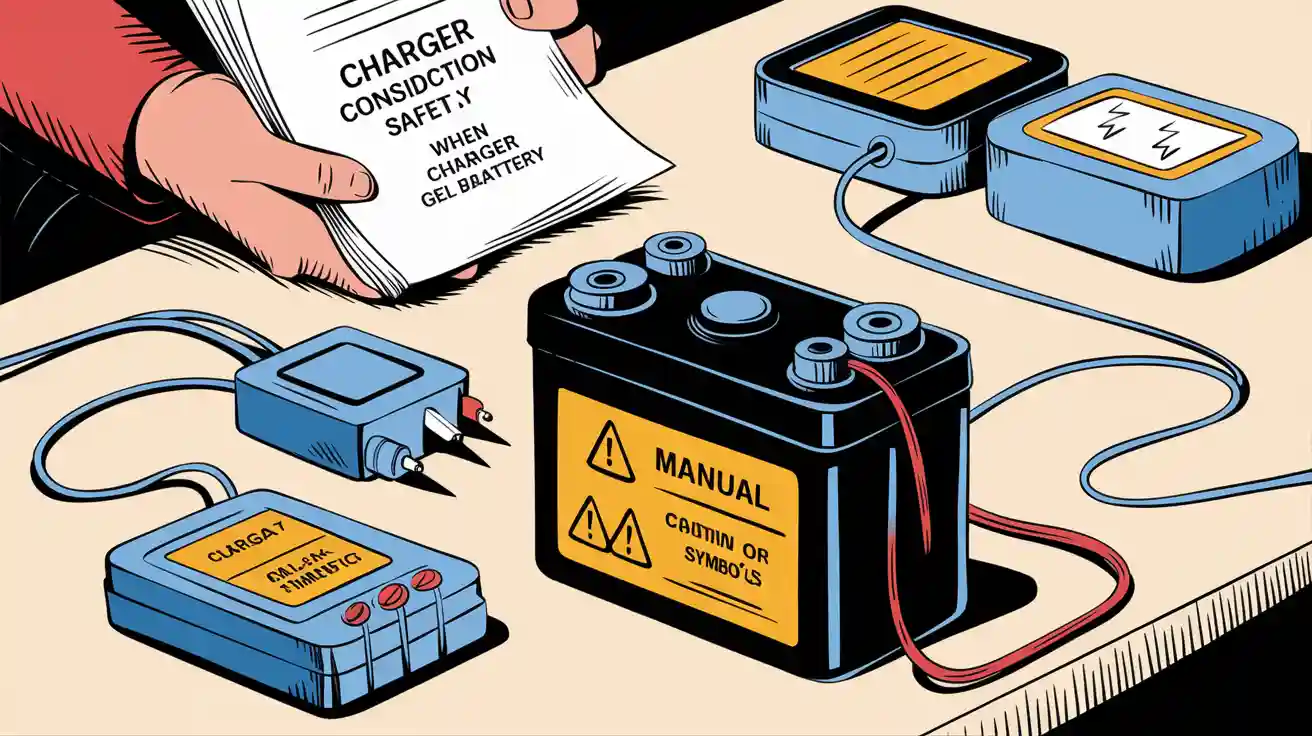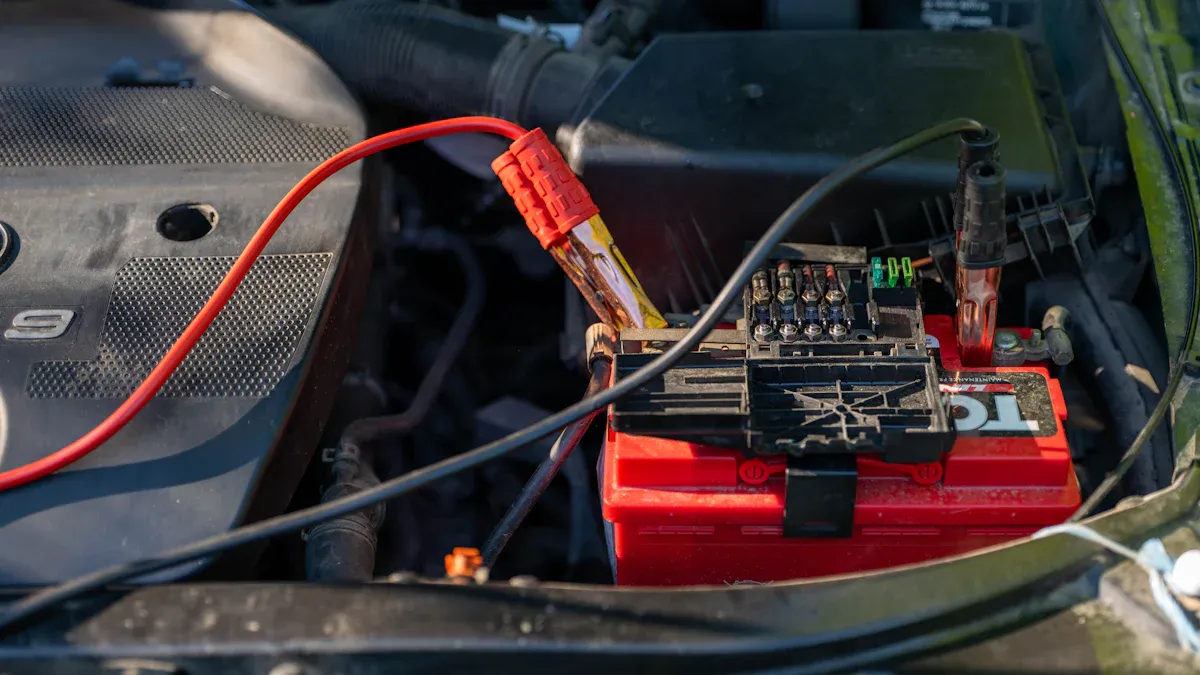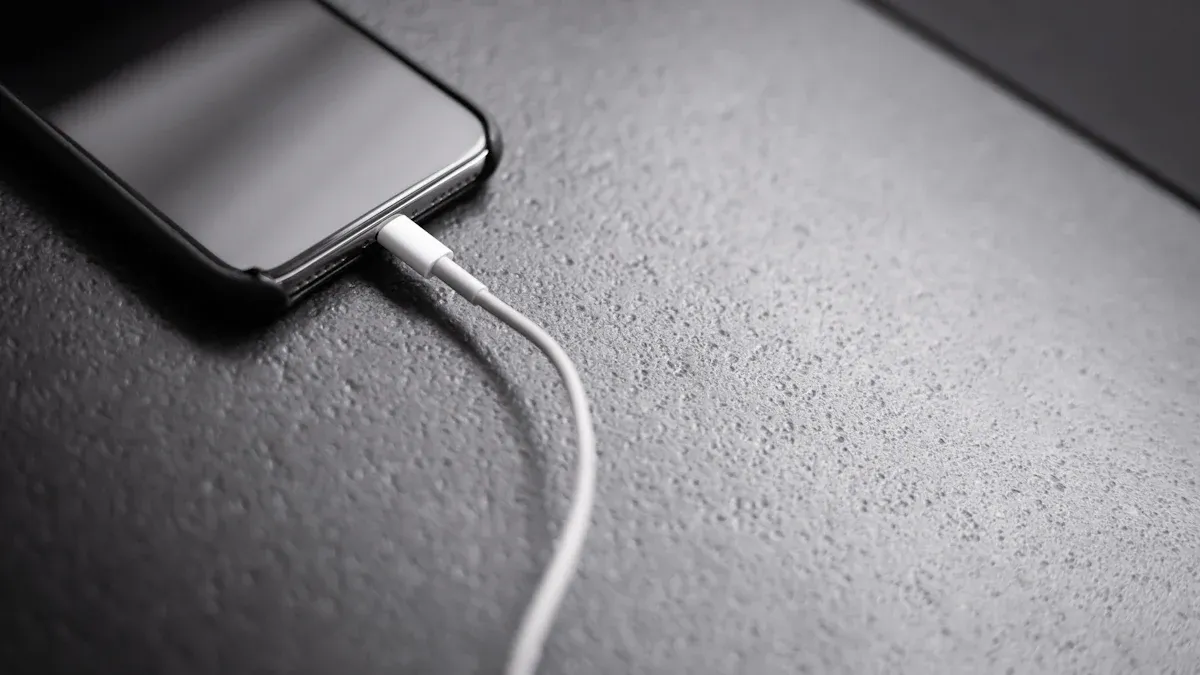
No, you cannot safely charge a gel battery with any charger. Gel battery charging requires precise control because gel batteries use a unique chemistry and need specific voltage limits. Using the wrong charger can cause:
Overcharging and overheating
Premature battery failure
Permanent damage due to incorrect voltage
Always use a charger designed for gel batteries to protect performance and lifespan.
Key Takeaways
Always use a charger designed specifically for gel batteries to avoid overcharging and permanent damage.
Gel batteries need precise voltage control and slow charging to protect their unique gel electrolyte and extend lifespan.
SMART chargers with gel-specific profiles offer the best protection by regulating voltage and current automatically, preventing overheating and battery failure.
Special Charging Needs
Unique Chemistry
Gel batteries use a special gel-like electrolyte created by adding silica to sulfuric acid. This design increases internal resistance and slows down chemical reactions inside the battery. You need to use a charger that delivers a lower, tightly controlled voltage—usually between 13.5V and 13.8V. Standard chargers for flooded or AGM batteries often provide higher voltages, which can damage gel batteries. Overcharging can dry out the gel, create air pockets, and cause permanent loss of capacity.
Tip: Always choose a gel-specific or SMART charger. These chargers prevent voltage spikes and provide the slow, constant voltage cycles that gel batteries require.
You will notice that gel batteries charge more slowly than other lead-acid types. This slow process helps extend cycle life and reduces the risk of overheating or damage.
Gel batteries are sensitive to improper charging.
Overcharging dries out the gel electrolyte.
Flooded batteries tolerate higher charge currents and voltages.
Gel batteries need continuous monitoring during charging.
Deep-Cycle Design
Gel batteries excel in deep-cycle applications. You can discharge them deeply and recharge them frequently without significant loss of capacity. Their sealed, maintenance-free design means you do not need to check water levels or clean terminals. The gel electrolyte prevents spills, making these batteries safer for use in demanding environments.
Long lifespan due to corrosion-resistant plates and sealed construction.
Reliable performance in extreme temperatures.
Low maintenance—no watering or regular checks needed.
Consistent power for traffic equipment, medical devices, and industrial systems.
You benefit from a battery that handles frequent, deep discharges and provides steady power in critical applications. The deep-cycle design, combined with careful charging, ensures long service life and dependable operation.
Gel Battery Charging Risks

Overcharging
Overcharging poses one of the greatest risks to gel batteries. When you use a charger that supplies too much voltage or current, the gel electrolyte inside the battery can dry out. This process creates gas bubbles, which increase internal pressure and may cause the battery case to swell or bulge. You cannot refill the gel electrolyte, so any loss is permanent. Overcharging also generates heat, which can warp internal plates and damage the sealed structure. If you use old-style trickle chargers or chargers designed for flooded lead-acid batteries, you risk “cooking” the battery. These chargers often lack voltage regulation and can supply constant current, leading to rapid battery failure.
Note: Smart chargers with gel-specific profiles help prevent overcharging. They use microprocessor control to adjust voltage and current, protecting battery health and extending service life.
Common symptoms and consequences of overcharging include:
Drying out of the gel electrolyte
Swelling or bulging of the battery case
Formation of gas bubbles within the gel
Increased internal temperature
Shortened battery lifespan
Damage Signs
You can spot damage in gel batteries by looking for physical and performance-related symptoms. If your battery fails to charge properly, this may indicate internal sulfation or cell damage. Rapid discharge after charging and overheating during use are warning signs. You may notice longer charging times and reduced ability to power devices. Physical damage often appears as cracks, leaks, bulging casing, or corrosion on terminals. A rotten-egg smell signals gas buildup from overcharging.
Voltage instability, such as rapid drops after charging
Inability to hold charge or resting voltage below 12.4V
Slow recharge times and reduced runtime
Bulging, swelling, cracks, or leaks
Corrosion on terminals
Rotten-egg odor from gas emission
You should perform visual inspections and load testing to assess battery health. If you see these signs, replace the battery to avoid further risks in critical applications like medical, industrial, or infrastructure systems.
Charger Specifications

Voltage Limits
You must pay close attention to voltage limits when charging gel batteries. The recommended voltage range for a 12V gel battery depends on the charging mode. During cyclic (boost) charging, you should set the voltage between 14.4V and 14.7V. For standby (float) charging, the safe range is 13.6V to 13.8V. Exceeding these limits can cause serious problems, including overcharging, gassing, and drying out of the gel electrolyte. These issues lead to plate damage and reduce battery lifespan.
Charging Mode | Recommended Voltage Range (12V Gel Battery) | Risks of Exceeding Voltage Range |
|---|---|---|
Cyclic (Boost) | 14.4V to 14.7V | Overcharging, gassing, drying out battery, plate damage |
Standby (Float) | 13.6V to 13.8V | Stress on battery if too high; slow charging if too low |
Charging currents above 20% of the battery’s 20-hour rating can also cause overheating and damage. You should always check the charger’s specifications and select a model that matches the voltage and current requirements for gel battery charging. This step ensures safety and prevents irreversible damage.
Tip: Use a charger with temperature compensation. This feature adjusts voltage based on ambient temperature, protecting the battery from overheating in hot environments.
Constant Voltage
Maintaining constant voltage and current during gel battery charging is critical for battery health. When you use a charger with constant voltage, the battery draws only the current it needs as it approaches full charge. This process prevents excessive current flow, which can cause overheating and damage. The battery acts as a current regulator, reducing current as its terminal voltage rises.
You should follow a three-stage charging process:
Bulk Stage: The charger supplies constant current until the battery reaches a set voltage.
Absorption Stage: The charger holds a constant voltage while the current tapers off.
Float Stage: The charger maintains a lower constant voltage to keep the battery fully charged without overcharging.
Charging current must stay within recommended limits. For example, a 3Ah gel battery should not exceed 0.87 amps during charging. If you allow excessive current, the gel electrolyte may dry out, and the battery will heat up rapidly. This damage is often irreversible.
Limit charging current to prevent gassing and drying out.
Monitor battery temperature to avoid overheating.
Use current-limiting circuits or resistors if needed.
Transition between charging stages at the correct voltage and current.
Proper regulation of voltage and current extends battery life and improves performance. You should avoid chargers that lack these controls, especially in critical applications such as Medical, Robotics, Security, Infrastructure, Consumer Electronics, and Industrial systems.
SMART Chargers
SMART chargers offer advanced features that protect gel batteries and improve charging efficiency. These chargers use microprocessor-controlled technology to regulate voltage and current precisely. You benefit from automatic multistage charging, which includes bulk, absorption, and float modes tailored for gel battery charging.
Feature | SMART Charger (e.g., BCS-A1204) | Standard Charger |
|---|---|---|
Charging Process | Fully automatic multistage (3-stage SmartCharge) | Typically manual or single-stage |
Voltage Control | Precise voltage tailored for GelTech batteries (Boost 14.1V, Float 13.7V) | Less precise, may not suit gel batteries |
Overcharge Protection | Built-in overcharge prevention | Often lacks overcharge protection |
Surge and Spike Protection | Included | Usually absent or minimal |
Short Circuit Protection | Included | Usually absent or minimal |
Operation Mode | ‘Set and Forget’ with automatic float mode after full charge | Manual monitoring often required |
Battery Sulphation Prevention | Prevents sulphation by maintaining safe voltage during storage | No specific prevention, risk of damage |
Safety for Long-Term Connection | Safe to leave connected long-term without damage | Risk of overcharging and damage |
Compliance | Meets Australian Electrical Standards & EMC | Varies, often no specific compliance |
Ideal Use | Maintaining infrequently used vehicles and gel batteries | General charging, not optimized for gel |
SMART chargers prevent over-voltage, which can dry out the gel electrolyte and permanently damage the battery. They skip the equalization phase used for flooded batteries, which is destructive for gel batteries. Temperature compensation adjusts voltage for ambient conditions, further improving safety. You can leave a SMART charger connected for long-term maintenance without worrying about overcharging or sulfation.
SMART chargers use dedicated gel battery charging profiles.
They regulate voltage and current automatically.
They protect against surges, spikes, and short circuits.
They extend battery cycle life and calendar life.
They maintain battery health during storage.
If you use a conventional charger, you risk excessive heat, electrolyte loss, and premature battery failure. SMART chargers provide peace of mind and reliable performance, especially in demanding B2B sectors. For lithium battery packs, you should also consider chargers with built-in BMS (Battery Management System) for optimal protection and monitoring.
Gel Battery Charging with Regular Chargers
Emergency Use
You may face situations where only a regular automotive charger is available for gel battery charging. In emergencies, you can use a standard charger for a short period, but you must monitor the process closely. Regular chargers often lack the precise voltage control needed for gel batteries. If you use them, you risk overcharging, which can create voids in the gel electrolyte and cause irreversible damage. Even new gel batteries can fail quickly when charged with non-specific chargers. You should disconnect the charger as soon as the battery reaches full charge to minimize harm.
⚠️ Alert: Emergency charging with a regular charger should be a last resort. Always switch back to a gel-specific or SMART charger as soon as possible.
Long-Term Effects
Charging gel batteries with non-recommended chargers over time leads to serious consequences. Gel batteries require chargers designed for their unique chemistry and lower voltage needs. If you use chargers meant for AGM or flooded batteries, you expose the battery to higher voltages and faster charging rates. This practice causes premature failure, voids, and bubbles in the gel electrolyte. The damage reduces battery capacity and shortens lifespan. You may notice the battery loses its ability to hold charge, and performance drops in critical applications such as Medical, Robotics, Security, Infrastructure, Consumer Electronics, and Industrial systems.
Permanent reduction in battery capacity
Increased risk of overheating and gas formation
Shortened cycle life and reliability
Higher maintenance costs and replacement frequency
You should always use chargers matched to gel battery chemistry to avoid irreversible damage and ensure safe operation in demanding environments.
Gel Battery Charging Guide
Preparation
Before you start gel battery charging, check the battery for any visible damage, leaks, or swelling. Make sure the terminals are clean and free from corrosion. Confirm that your charger matches the voltage and current requirements for gel batteries. If you use the battery in critical sectors like Medical, Robotics, or Security, inspect all connections and cables for secure attachment. Place the battery in a well-ventilated area away from heat sources.
Charging Steps
Connect the charger’s positive lead to the battery’s positive terminal.
Attach the negative lead to the negative terminal.
Set the charger to the correct gel battery charging mode or profile.
Start the charger and monitor the process. Watch for any signs of overheating or swelling.
When the charger indicates a full charge, disconnect the leads in reverse order.
⚡ Tip: Use a SMART charger with automatic shutoff to prevent overcharging and extend battery life.
Maintenance
Regular maintenance keeps your gel battery reliable and efficient over time.
Charge before the battery fully discharges and avoid overcharging to prevent damage.
Inspect the battery often for corrosion, loose connections, or physical damage.
Keep the battery within recommended temperature ranges. Extreme heat speeds up wear, while cold lowers capacity.
Following these steps helps prevent damage, extends lifespan, and ensures consistent operation in demanding environments like Infrastructure, Consumer Electronics, and Industrial systems.
Lithium Battery Comparison
When you compare gel batteries to lithium battery packs, you notice several important differences in charging, performance, and safety. Lithium batteries, such as lithium-ion, LiFePO4, lithium-polymer/LiPo, and solid-state battery, have become popular in Medical, Robotics, Security, Infrastructure, Consumer Electronics, and Industrial sectors.
Key Charging and Performance Differences:
You can fully charge a LiFePO4 battery in about 2 hours, which supports frequent use and high productivity.
Gel batteries charge slowly and require lower voltage, which limits fast charging applications.
Lithium batteries deliver higher voltage and capacity, and you can discharge them up to 80–90% without harming lifespan. Gel batteries should stay above 50% depth of discharge for best results.
Lithium batteries offer faster, more efficient charging, making them ideal for demanding B2B environments.
Battery Type | Safety Features |
|---|---|
Gel-like electrolyte prevents leaks and spills. Maintenance-free and spill-proof. Lower explosion risk than flooded lead-acid. | |
Lithium Batteries | Built-in thermal stability and BMS monitor temperature, voltage, and current. Modern designs reduce risk of thermal runaway. Require careful handling and thermal management. |
You protect gel battery health and maximize lifespan by using chargers with correct specifications. Incompatible chargers cause premature failure, void warranties, and reduce performance.
Select smart chargers with gel-specific profiles for best results.
Follow manufacturer guidelines and consult experts for B2B solutions.
For tailored advice, request a custom battery solution.
FAQ
Can you use a lithium-ion charger for gel batteries?
No, you cannot use a lithium-ion charger for gel batteries. You risk damaging the gel battery due to different voltage and charging profiles.
How do you select the right charger for gel batteries in industrial applications?
You should choose a SMART charger with gel-specific settings. Large Power offers custom solutions for Industrial needs. Request a consultation for custom battery solutions.
What is the safest way to maintain gel batteries in medical or robotics sectors?
You should use a charger with automatic voltage regulation. Large Power recommends regular inspections for Medical and Robotics applications.




